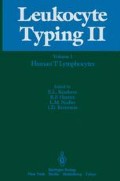Abstract
Monoclonal antibodies have become extraordinary specific tools for identifying cell subpopulations such as, for example, lymphocytes. In utilizing them in such a manner, it has become clear that due to their specificity for a given epitope, they can also give apparent loss of specificity when reacting with one epitope shared by two different unrelated antigens. We have prepared monoclonal antibodies against human lymphoid cells with the aim of selecting antibodies specific for antigens defining lymphocyte subpopulations. In the course of the selection process, we screened hybridoma supernatants on normal human skin as a non-lymphoid organ. We found unexpected and interesting staining patterns (1) which led us to generalize these control screenings and to select monoclonal antibodies recognizing most human skin cells. The 159 monoclonal antibodies of the panel for T cell studies were screened on human skin sections in the same manner; 21 of them were found to react on skin components. The possible biological significances of these cross-reactivities will be discussed.
Access this chapter
Tax calculation will be finalised at checkout
Purchases are for personal use only
Preview
Unable to display preview. Download preview PDF.
References
Thivolet, J., D. Schmitt, J. Viac, and J. Brochier. 1983. Les antigènes reconnus par les anticorps monoclonaux antilymphocytes peuvent avoir une localisation tissulaire inattendue. C.R. Acad. Sci. Paris 296: 203.
Kohler, G., and C. Milstein. 1975. Continuous cultures of fused cells secreting antibody of predefined specificity. Nature 256: 495.
Viac, J., A. Reano, J. Brochier, M.J. Staquet, and J. Thivolet. 1983. Reactivity pattern of a monoclonal antikeratin antibody (KL1). J. Invest. Dermatol. 81: 351.
Viac, J., M. Haftek, M. J. Staquet, A. Reano, J. Brochier, and J. Thivolet. 1984. A monoclonal antibody labelling the keratinocyte membrane: a marker of epidermal differentiation. Acta Dermatovener (Stockholm) in press.
Klareskog, L., U.M. Tjernlund, and M. Fosum. 1977. Epidermal Langerhans cells express la antigen. Nature 26: 248.
Fithian, E., P. Kung, G. Goldstein, M. Rubenfeld, C. Fenoglio, and R. Edelson. 1981. Reactivity of Langerhans cells with hybridoma antibody. Proc. Natl. Acad. Sci. U.S.A. 78: 3858.
Yonish-Rouach, E., D. Schmitt, J. Viac, R. Knowles, G. Cordier, and J. Brochier. 1984. Monoclonal anti-thymic cell antibodies detecting epidermal cells. Thymus 6: 67.
Brochier, J., S. Saeland, G. Cordier, and D. Schmitt. 1984. An antilymphocyte monoclonal antibody (HB8) which cross reacts with human dermal elastic fibers. Immunol. Lett. 7: 279.
Brochier, J., D. Schmitt, E. Yonish-Rouach, G. Cordier, and J. Viac. 1984. Use of tissue distribution studies to determine the specificity of monoclonal antilymphocyte antibodies. In: Leucocyte typing, A. Bernard, L. Boumsell, J. Dausset, C. Milstein, and S. Schlossman, eds. Springer-Verlag, Berlin, Heidelberg, p. 465.
Takesaki, S., S.L. Morrison, C.L. Berger, G. Goldstein, A.C. Chu, and R.L. Edelson. 1982. Biochemical characterization of a differentiation antigen shared by human epidermal Langerhans cells and cortical thymocytes. J. Clin. Immunol. 2: 1285.
Bernard, A., L. Boumsell, J. Dausset, C. Milstein, and S. Schlossman, eds. 1984. Leucocyte typing. Springer-Verlag, Berlin, Heidelberg.
Wood, G.S., N.L. Warner, and R.A. Warnke. 1983. Anti-Leu-3/T4 antibodies react with cells of monocyte/macrophage and Langerhans lineage. J. Immunol. 131: 212.
Schmitt, D., M. Faure, C. Dambuyant-Dezutter, and J. Thivolet. 1984. The semi-quantitative distribution of T4 and T6 surface antigens on human Langerhans cells. Brit. J. Dermatol. 111: 655.
Guilbert, B., G. Dighiero, and S. Avrameas. 1982. Naturally occurring antibodies against nine common antigens in human sera. I. Detection, isolation and characterization. J. Immunol. 128: 2779.
Monier, J.C., J. Brochier, A. Moreira, C. Sault, and B. Roux. 1984. Generation of hybridoma antibodies to double-stranded DNA from non autoimmune Balb/c strain. Studies on anti-idiotype. Immunol. Lett. 8: 61.
Editor information
Editors and Affiliations
Rights and permissions
Copyright information
© 1986 Springer-Verlag New York Inc.
About this paper
Cite this paper
Brochier, J., Schmitt, D. (1986). Cross-reactivity of Anti-lymphocyte Monoclonal Antibodies on Human Skin Components. In: Reinherz, E.L., Haynes, B.F., Nadler, L.M., Bernstein, I.D. (eds) Leukocyte Typing II. Springer, New York, NY. https://doi.org/10.1007/978-1-4613-8587-5_33
Download citation
DOI: https://doi.org/10.1007/978-1-4613-8587-5_33
Publisher Name: Springer, New York, NY
Print ISBN: 978-1-4613-8589-9
Online ISBN: 978-1-4613-8587-5
eBook Packages: Springer Book Archive

